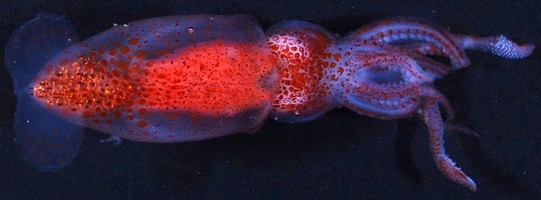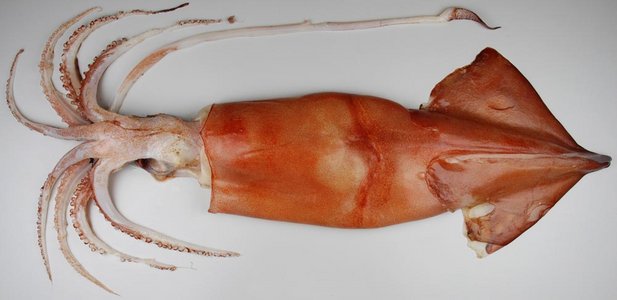Psychroteuthidae
Psychroteuthis glacialis
Uwe PiatkowskiIntroduction
Psychroteuthis glacialis is a muscular squid of moderate size (44 cm ML) (Nesis, 1982). Studies in the Weddell Sea found that "this is the most abundant muscular squid in the Weddell Sea and the only pelagic cephalopod which occurs in considerable numbers in the Antarctic Sea Ice Zone" (Piatkowski and Steimer, in manuscript). The species is a major prey item for predators such as large fish, birds, seals and toothed whales in Antarctic waters.
A specimen of the second possible species was taken from the stomach of a sperm whale captured off the Bonin Islands in the North Pacific (Nesis, 1982) and Roper et al. (1969) suggest that there may be two species in Antarctic waters. Little is known about the ecology of this squid in spite of its importance in the Antarctic ecosystem.
Brief diagnosis:
A member of the histioteuthid families ...
- without integumental photophores on head, arms or mantle.
Characteristics
- Photophores
- Tips of third arms of mature males with large glandular structures, similar structures on tips of arms II-III of mature females. These structures are presumably photophores; otherwise photophores absent.
- Tentacles
- Club with suckers not in uniform series; four to seven suckers in a transverse row.
- Locking apparatus extends distally along the dorsal side of the stalk and proximally along the ventral side.
 Click on an image to view larger version & data in a new window
Click on an image to view larger version & data in a new window
Figure. Oral view of the tentacular club of P. glacialis, 405 mm ML, Ross Sea, Antarctica. Photograph by Peter Marriott.
- Head
- Beaks: Descriptions can be found here: Lower beak; upper beak.
- Beaks: Descriptions can be found here: Lower beak; upper beak.
Nomenclature
A list of all nominal genera and species in the Psychroteuthidae can be found here. The list includes the current status and type species of all genera, and the current status, type repository and type locality of all species and all pertinent references.
Life History
Size-frequency data suggests a two-year life-cycle with males maturing sooner and at a smaller size than females (Piatkowski and Steimer, in manuscript).



Figure. Two views of a paralarva of P. glacialis captured in the Ross Sea, Antarctica. It shows striking similarity to paralarvae of the Histioteuthidae in the shape of the fins, tentacular club with small suckers compared to those of the arms, and the anterior position (i.e., adjacent to the cephalic cartilage) of the digestive gland. Photographs by D. Stevens.
Distribution
Vertical distribution
In the Weddell Sea, P. glacialis was taken between depths of 230 and 920 m with bottom and bentho-pelagic trawls (Piatkowski and Steimer, in manuscript).
Geographical distribution
P. glacialis has a circumpolar distribution in Antarctic waters. A map of their distribution can be seen here.
References
Gröger, J., Piatkowski, U. & Heinemann, H., 2000. Beak length analysis of the Southern Ocean squid Psychroteuthis glacialis (Cephalopoda: Psychroteuthidae) and its use for size and biomass estimation. Polar Biology, 23(1): 70-74.
Nesis, K. N. 1982. Abridged key to the cephalopod mollusks of the world's ocean. 385+ii pp. Light and Food Industry Publishing House, Moscow. (In Russian.). Translated into English by B. S. Levitov, ed. by L. A. Burgess (1987), Cephalopods of the world. T. F. H. Publications, Neptune City, NJ, 351pp.
Piatkowski, U. and S. Steimer (In manuscript) The glacial squid Psychroteuthis glacialis: distribution in the Weddell Sea, Antarctica. Antarctic conference abstract.
Roper, C. F. E., R. E. Young and G. L. Voss (1969). An illustrated key to the families of the order Teuthoidea. Smiths. contr. zool., 13:1-32.
Title Illustrations

| Location | Ross Sea, Antarctica at 72°04'S, 175°44'E |
|---|---|
| Acknowledgements | New Zealand part of the International Polar Year and the Census of Antarctic Marine Life (NZ IPY-CAML) |
| Specimen Condition | Fresh |
| Identified By | Darren Stevens |
| View | Dorsal |
| Size | 405 mm ML |
| Collector | Land Information New Zealand (LINZ) |
| Copyright | © Peter Marriott NZ IPY-CAML |
About This Page
Uwe Piatkowski

Leibniz-Institut für Meereswissenschaften
Page copyright © 2016 Uwe Piatkowski
All Rights Reserved.
- Content changed 20 March 2011
Citing this page:
Piatkowski, Uwe. 2011. Psychroteuthidae . Psychroteuthis glacialis . Version 20 March 2011 (under construction). http://tolweb.org/Psychroteuthis_glacialis/19783/2011.03.20 in The Tree of Life Web Project, http://tolweb.org/










 Go to quick links
Go to quick search
Go to navigation for this section of the ToL site
Go to detailed links for the ToL site
Go to quick links
Go to quick search
Go to navigation for this section of the ToL site
Go to detailed links for the ToL site